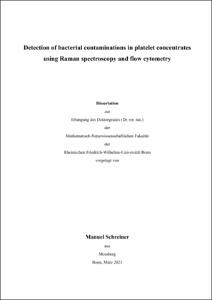Detection of bacterial contaminations in platelet concentrates using Raman spectroscopy and flow cytometry

Detection of bacterial contaminations in platelet concentrates using Raman spectroscopy and flow cytometry

| dc.contributor.advisor | Bekeredjian-Ding, Isabelle | |
| dc.contributor.author | Schreiner, Manuel | |
| dc.date.accessioned | 2023-10-17T16:06:43Z | |
| dc.date.available | 2024-11-01T23:00:21Z | |
| dc.date.issued | 17.10.2023 | |
| dc.identifier.uri | https://hdl.handle.net/20.500.11811/11103 | |
| dc.description.abstract | Transfusion of contaminated platelet concentrates (PC) implicates the risk of systemic infections leading to fatal sepsis, due to ideal growth conditions for bacteria during storage. Despite that, microbiological testing of PC in Germany is only performed as a random quality control and for shelf-life extension.
The current gold standard of microbiological quality testing of blood products are culture-based methods. Here, bacterial contaminations are identified on the basis of morphological and metabolic characteristics. Although these methods are well established and reliable, they have specific drawbacks. Culture-based test methods have high detection sensitivity, depending on the bacterial load, when sample volumes are sufficiently large. However, this detection method is very time consuming and has significant safety deficiencies due to the preferred "negative-to-date" product release of PC. To overcome the limitations of established techniques in pathogen diagnostics of blood products, the introduction of minimally invasive, rapid and reliable testing methods is crucial. In this thesis, the potential of a combination of Raman spectroscopy and confocal microscopy as a culture-independent, minimal-invasive detection method for bacterial contamination in PC was investigated. For this purpose, Raman spectra of PC contaminated with platelet transfusion-relevant bacteria reference strains (PTRBRs) and non-contaminated PC were analysed. Preprocessing of Raman spectral data and multivariate data analysis were performed. Classification of spectra with respect to bacterial contamination was based on principal component analysis (PCA) combined with linear discriminant analysis (LDA) of spectral data libraries. Models were also subjected to k-fold cross-validation. Analyses were performed using Raman Analyst software 0.2.0.0 (Leibniz-IPHT, Jena, Germany) and results were summarized in confusion tables. Determination of the detection limit of bacterial contaminants by Raman microspectroscopy showed that detection in TPC was only possible at high bacterial loads (>108 CFU/ml). Flow cytometry enables the rapid detection of microbes, regardless of their cultivability. In addition, quantitative analysis of the bacterial load (bioburden) can be performed. In this work, a new staining protocol for bacteria in PC was developed using the DNA-intercalating fluorescent dye DRAQ5TM. Selective lysis with Triton X-100 allowed the majority of all platelets in the samples to be lysed to stain for possible bacterial contaminants. Prior to this lysis step, platelet activation and aggregation were inhibited with the glycoprotein (GP) IIb/IIIa receptor blocker Tirofiban to optimize lysis efficiency and prevent sample clumping during sample treatment. To evaluate the detection limit, the PC samples were analysed after addition of defined PTRBR concentrations. Using flow cytometry, it was possible to reliably detect bacterial contamination of approximately 103-105 CFU/ml in PC in less than 2 hours. For S. aureus contaminations in PC, a specially adapted detection strategy was developed, making it possible to detect contamination levels of 102 CFU/ml in less than 2 hours. In this thesis, a new methodology for flow cytometric detection of transfusion-relevant bacteria in PC was developed and compared with the validated BactiFlow® system. The new application offers a cost-effective and vendor-independent alternative to the currently used rapid flow cytometric microbiological methods. | en |
| dc.language.iso | eng | |
| dc.rights | In Copyright | |
| dc.rights.uri | http://rightsstatements.org/vocab/InC/1.0/ | |
| dc.subject | Schnellnachweisverfahren | |
| dc.subject | transfusionsrelevante Bakterien | |
| dc.subject | Thrombozyten | |
| dc.subject | Durchflusszytometrie | |
| dc.subject | Raman-Spektroskopie | |
| dc.subject.ddc | 570 Biowissenschaften, Biologie | |
| dc.title | Detection of bacterial contaminations in platelet concentrates using Raman spectroscopy and flow cytometry | |
| dc.type | Dissertation oder Habilitation | |
| dc.publisher.name | Universitäts- und Landesbibliothek Bonn | |
| dc.publisher.location | Bonn | |
| dc.rights.accessRights | openAccess | |
| dc.identifier.urn | https://nbn-resolving.org/urn:nbn:de:hbz:5-71931 | |
| ulbbn.pubtype | Erstveröffentlichung | |
| ulbbnediss.affiliation.name | Rheinische Friedrich-Wilhelms-Universität Bonn | |
| ulbbnediss.affiliation.location | Bonn | |
| ulbbnediss.thesis.level | Dissertation | |
| ulbbnediss.dissID | 7193 | |
| ulbbnediss.date.accepted | 01.08.2023 | |
| ulbbnediss.institute.other | Paul-Ehrlich-Institut, Langen | |
| ulbbnediss.fakultaet | Mathematisch-Naturwissenschaftliche Fakultät | |
| dc.contributor.coReferee | Schneider, Tanja | |
| ulbbnediss.date.embargoEndDate | 01.11.2024 |
Files in this item
This item appears in the following Collection(s)
-
E-Dissertationen (4379)




